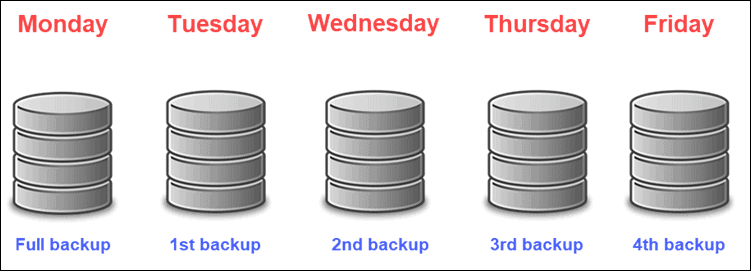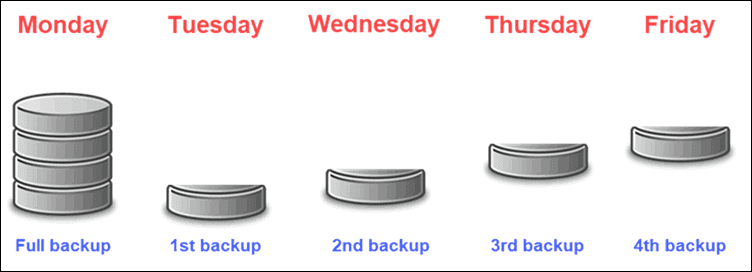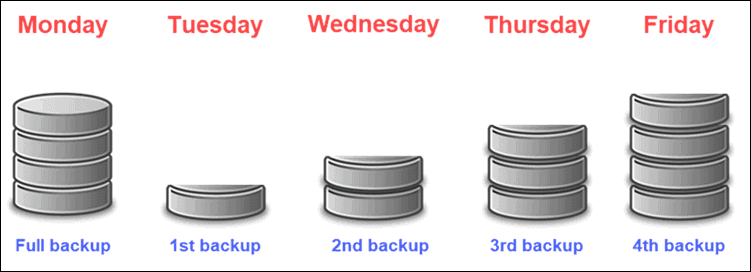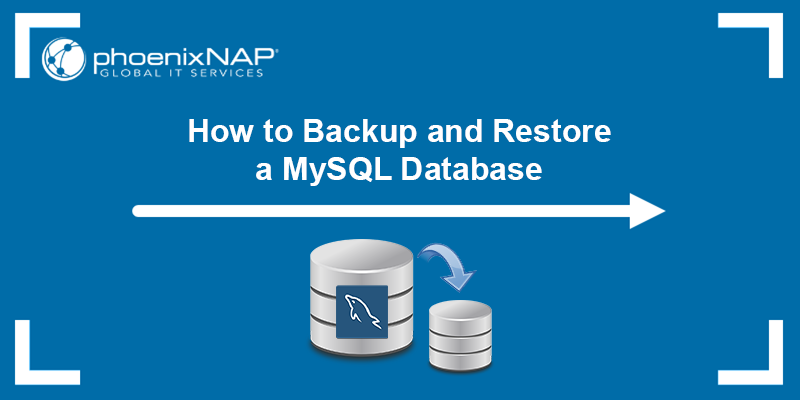When setting up a backup plan, you need to take into consideration the resources available, as well as the amount of data you need to protect.
With many different backup options to choose from, you may want to see a detailed comparison and explanation for each option before you can decide which one to go for.
In this tutorial, you will learn how these different types of backups work and what their pros and cons are.

Types of Backup
There are three basic types of backup:
- Full backup
- Incremental backup
- Differential backup
Initially, full backup was the way most users protected their system data. Over time, the demand for lighter, more flexible options influenced the development of new backup approaches.
Some users don’t commit to a single backup approach. Instead, they design a backup plan incorporating two or more backup options according to the amount of data they deal with.
Below you will find the most important features of the three commonly used backup types. Understanding the basics of full, incremental, and differential backup will help you determine which option is best for you.
Full vs Incremental vs Differential Backup: Quick Comparison
| FULL | INCREMENTAL | DIFFERENTIAL | |
|---|---|---|---|
| Description: | copies the entire data set | full backup + changes since the previous backup | full backup + changes since the full backup |
| Backup time: | time-consuming | fast to back up | faster than a full backup but slower than an incremental |
| Recovery time: | fast recovery | slow recovery | faster than incremental but slower than full |
| Storage space: | requires a lot of storage space | requires less storage space | requires less storage space than a full backup, but more than an incremental |
| Bandwidth: | uses a lot of bandwidth | uses less bandwidth | uses less bandwidth than a full backup, but more than an incremental backup |
Full Backups
A full backup involves copying the entire data set of the system into a separate partition or onto an external disk.
Because it creates a full copy of the specified data volume, it requires a lot of free disk space where the copy can be stored. What’s more, doing a backup of the entire system takes up a lot of time and is not practical on a daily basis.
Therefore, most companies schedule full backups on a daily, weekly, or biweekly basis, running incremental or differential backups in between. The frequency of full backups mainly depends on the size of the company.
For instance, a mid-sized company may set up daily backups of the entire data volume from Monday to Friday. In that case, their backup plan would appear as in the following image:

Pros and Cons of Full Backups
PROS:
- provides the best protection in terms of data recovery
- fast recovery of data in a single backup set
CONS:
- backup is time-consuming
- requires more storage space
- uses up a lot of bandwidth
Incremental Backups
An incremental backup is a resource-friendly alternative to full backup. Such a setup is designed only to back up data that has changed since the previous backup. Therefore, it exclusively saves data that has been modified or added to the existing data volume.
For a closer look at how incremental backups work, let’s use a simple example.
A smaller-sized company that doesn’t require full backups daily can set up incremental backups between two full backup occurrences.
An administrator can arrange a full backup of the data set on Monday and then incremental backups between Tuesday and Friday. Therefore, on Tuesday, it creates copies of any changes that have been made since Monday. Next, on Wednesday, it will back up any changes made since Tuesday, and so on.
As a result, the weekly backup will consist of one full backup along with several smaller backup sets. This method is efficient as it takes up less space on the system. Also, since the sets are smaller compared to the volume set, they take less time to back up.

The downside to using this method is that each incremental backup depends on the one before it. This means that any damage or loss on one of the sets may inflict incomplete data recovery. Having a larger number of backup sets also affects recovery time.
Pros and Cons of Incremental Backups
PROS:
- smaller backups that take up less storage space
- faster to backup
- uses less bandwidth
CONS:
- time-consuming to recover
- risk of failed recovery if there is damage to a segment in the backup chain
Differential Backups
A differential backup is similar to incremental as it relies on a full backup, followed by saving only the changes made on that source volume.
However, it differs in the way these changes are saved. While incremental backups save all changes made since the last backup, differential backups save changes made since the last full backup.
With such a setup, the backup sets do not rely on each other, but rather on the full backup they stem from. As they only consist of two backup sets, their recovery time is much better. This provides better data protection and a valid disaster recovery solution.
In the following example, you see a five-day incremental backup plan. It starts with a full backup on Monday. On Tuesday, it saves only the changes made on the data source. On Wednesday, the backup set consists of all the changes made from Monday to Wednesday. The same procedure is applied on Thursday and Friday.

While this method is faster to restore, it does take some time to back up and requires more storage space than an incremental backup.
Pros and Cons of Differential Backups
PROS:
- faster to restore as it only has two backup sets
- faster to back up compared to full backups
- takes up less space than full backups
CONS:
- takes up more space than incremental backups
- slower to back up compared to incremental backups
Conclusion
You should now have a good understanding of the three basic types of backups. As you have seen, each one has its own benefits and drawbacks. Therefore, setting up your backup plan with one or the other will depend on your needs, priorities and resources.
Check out our article on Snapshot vs. Backup comparison to learn the differences between these two ways of creating a copy of your data or check out our Backup vs. Replication article to learn the difference between these two ways of securing and preserving your data.


